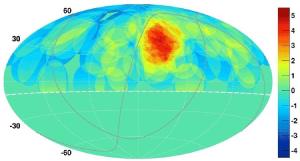Blog
Not So Random
16 July 2014
 Abbasi, RUea, et al
Abbasi, RUea, et alGamma ray bursts (GRBs) are brief, intense bursts of gamma rays. They were first detected in the 1960s as part of a project to observe nuclear weapons tests. Since then we’ve been able to observe lots of gamma ray bursts, as they occur at a rate of about once a day. We aren’t entirely sure what causes them. One idea is that they occur when a hypergiant star collapses into a black hole. If that were the case, then we would likely see bursts come from random directions (if they originate from outside our galaxy) or along the galactic plane (if they originate in our own galaxy). But now a new study has shown that neither is the case.1
The results are being published in the Astrophysical Journal Letters. What the team did was to analyze the direction of high energy GRBs over a five year period. During that time 72 ultra high energy GRBs were detected, and 19 of them were clustered in a small region of sky near the Big Dipper. You can see this clustering in the image above. This region of sky is not part of the galactic plane, but it is in the direction of the Virgo supercluster, of which the Milky Way is a part.
So it seems that the most energetic gamma ray bursts are clustered in the same way that nearby galaxies are clustered. This suggests that they may be powered by active black holes in the centers of galaxies.
Abbasi, RUea, et al. “Indications of intermediate-scale anisotropy of cosmic rays with energy greater than 57 EeV in the northern sky measured with the surface detector of the Telescope Array experiment.” The Astrophysical Journal Letters 790.2 (2014): L21. ↩︎